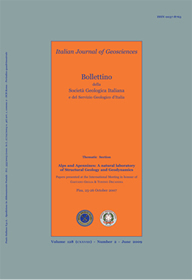
Structural evolution of a foreland basin succession: the Dauna Unit in the sannio-molise sector of the Southern Apennines
Sara Pertusati(*) & Alfonsina Buonanno(*)
(*) Dipartimento di Studi Geologici ed Ambientali, Università degli Studi del Sannio, Via dei Mulini, 59/A - 82100 Benevento-Italy. Phone: +39 0824 323615. E-mail: sarap@unisannio.it.
Volume: 128 (2009) f.2
Pages: 551-564
Abstract
Geological mapping and structural analysis carried out in the Sannio-Molise sector of the Southern Apennines provide a complete record of the polyphase deformation sequence affecting the succession of the Daunia Unit. These deposits represent an ancient foredeep turbiditic succession, deposited from Oligocene to upper Tortonian and involved in the Apennine tectonics since upper Tortonian times.
Two main contractional stages can be distinguished in the structural evolution of the Daunia Unit: the first deformation stage, which consists of initial layer-parallel-shortening and in the development of thrusts and metre- to decametre-scale wavelength folds (F1 and F2) developed in an extremely short time, between the upper Tortonian and pre-salinity crisis Messinian. The timing of this first deformation phase is well constrained by the presence of thrust-top Messinian-Pliocene deposits extensively outcropping in the studied area.
The second stage of the contractional deformation is characterized by gentle folds with sub-vertical axial surfaces (F3), metre- to hectometre-scale in wavelength, and breaching thrusts, active at least until the middle Pliocene.
Finally, the Daunia Unit has been affected by extensional tectonics characterized by the development of mainly NW-SE and NE-SW trending normal faults.
Keywords
Get Full Text